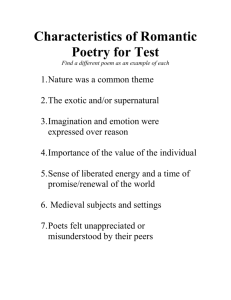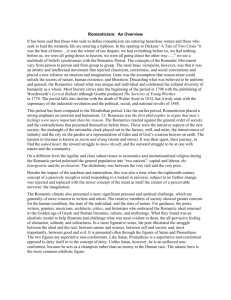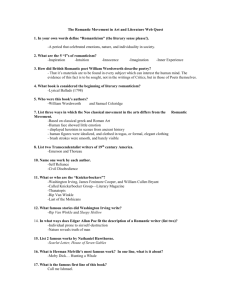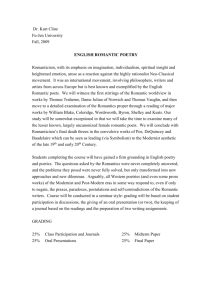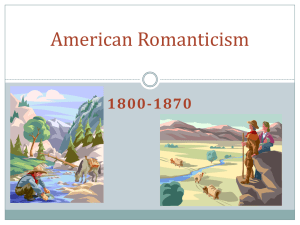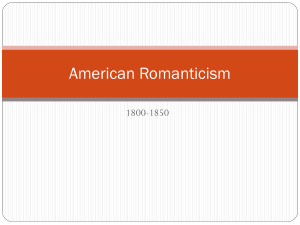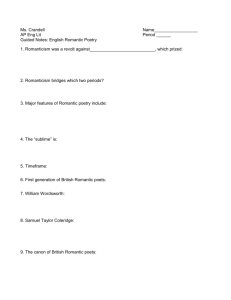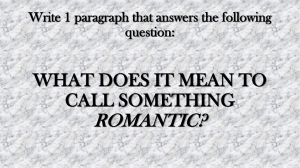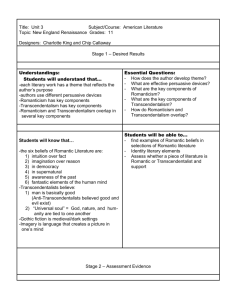ROMANTIC PERIOD
advertisement
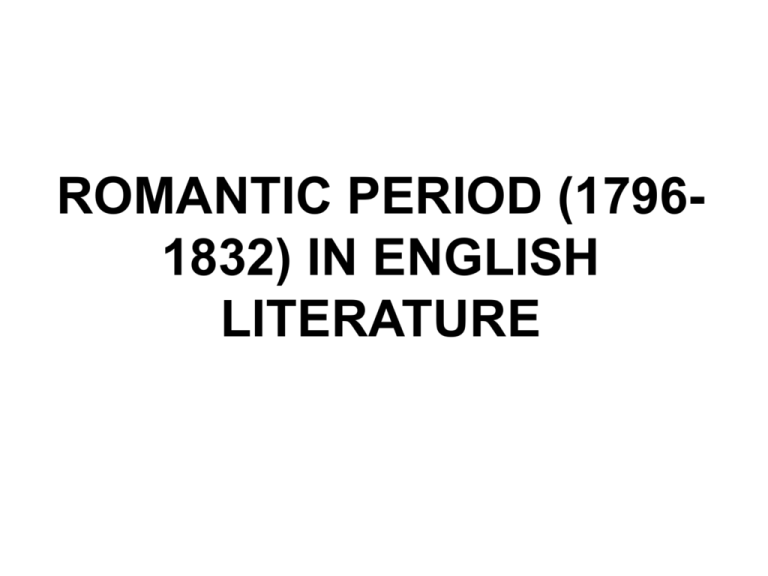
ROMANTIC PERIOD (17961832) IN ENGLISH LITERATURE The Romantic Period in English literature is taken to begin with the publication of Wordsworth and Coleridge`s Lyrical Ballads and end with the death of the novelist, Sir Walter Scott. The historical and literary contexts and effects covered a broader time span. No other period in English literature displays more variety in style, theme, and content than the Romantic Movement of the eighteenth and nineteenth centuries. Furthermore, no period has been the topic of so much disagreement and confusion over its defining principles and aesthetics. In England, Romanticism had its greatest influence from the end of the eighteenth century up to 1832, all the way up to about 1870. Its primary vehicle of expression was in poetry. Because the expression Romanticism is a phenomenon of immense scope, embracing as it does, literature, politics, history, philosophy and the arts in general, there has never been much agreement and much confusion as to what the word means. It has, in fact, been used in so many different ways that some scholars have argued that the best thing we could do with the expression is to abandon it once and for all. However, the phenomenon of Romanticism would not become less complex by simply throwing away its label of convenience. Romanticism is a movement in art and literature in the eighteenth and nineteenth centuries in revolt against the Neoclassicism of the previous centuries. The German poet Friedrich Schlegel, who is given credit for first using the term romantic to describe literature, defined it as "literature depicting emotional matter in an imaginative form." Imagination, emotion, and freedom are certainly the focal points of Romanticism. Any list of particular characteristics of the literature of Romanticism includes subjectivity and an emphasis on individualism; spontaneity; freedom from rules; solitary life rather than life in society; the beliefs that imagination is superior to reason and devotion to beauty; love of and worship of nature. The collection of poems published as Lyrical Ballads in 1798 by William Wordsworth (1770-1850) and Samuel Taylor Coleridge (1772-1834) has traditionally been seen as the birthplace of English Romanticism. The other English Romantic poets are William Blake (1757-1827), George Byron (1788-1824), Percy Bysshe Shelley (1792-1822), John Keats (17951821). The word romantic (ism) has a complex and interesting history. In the Middle Ages 'romance' denoted the new vernacular languages derived from Latin - in contradistinction to Latin itself, which was the language of learning. Enromancier, romancar, romanz meant to compose or translate books in the vernacular. The work produced was then called romanz, roman, romanzo and romance. A roman or romant came to be known as an imaginative work and a 'courtly romance'. The terms also signified a 'popular book'. There are early suggestions that it was something new, different, divergent. By the 17th century in Britain and France, 'romance' has acquired the derogatory connotations of fanciful, bizarre, exaggerated, chimerical. In France a distinction was made between romanesque (also derogatory) and romantique (which meant 'tender', 'gentle', 'sentimental' and 'sad'). It was used in the English form in these latter senses in the 18th centiry. In Germany the word romantisch was used in the 17th century in the French sense of romanesque, and then, increasingly from the middle of the 18th century, in the English sense of 'gentle', 'melancholy'. It is one of the curiosities of literary history that the strongholds of the Romantic Movement were England and Germany, not the countries of the romance languages themselves. Our colloquial use of "romance" and "romantic" to describe intense emotional experiences can be traced back to this medieval sense of the word, and so can the 18th and 19th century concept of "Romanticism” as an intellectual experience. “Romantic" has in fact been used since the Renaissance to suggest free expression of the imagination in the arts, but mainly in a negative sense. Romantic imaginings were thought to interfere with the clarity of the art form, and so lay beyond the bounds of proper subject-matter. The term is used in many senses, a recent favorite being that which sees in the romantic mood a psychological desire to escape from unpleasant realities. Thanks to the influence of late 18th century German cultural theorists, "Romanticism" was adopted across Europe and the New World as a convenient description for distinctively contemporary modes of thought, losing in the process many of its negative connotations. Instead of "improbable" notions and "false" sensibility, Romanticism came to stand for authenticity, integrity and spontaneity. It was seen as a positive artistic and intellectual assertion of the extremes in the human psyche, the areas of experience beyond logic and reason which could only be expressed in a direct and heartfelt way. These new concerns were seen as a valid response to the extremes of change and uncertainty which the age itself displayed. The Western world had been shaken by two political revolutions, in America (1776) and France (1789), and by an industrial revolution which was beginning to erode the traditionally agrarian lives of many people. New ways of living had to be reflected in new ways of thinking. Romanticism, for want of any better word, came to stand for this new experience of the world. The true Romantic was not an over-sensitive dreamer, but a heroic figure facing headon the painful realities of his time - a figure of genius. Romanticism has very little to do with things popularly thought of as "romantic," although love may occasionally be the subject of Romantic art. The Romantic Period in literature has very little to do with things popularly thought of as "romantic," although love may occasionally be the subject of Romantic art. Today, in literary theory and history there is a distinction between the popular usage of romanticism and romantic, and the scholarly usage to name the Romantic period and Romanticism as a literary movement. Definitions of Romanticism Romanticism: a movement of the eighteenth and nineteenth centuries that marked the reaction in literature, philosophy, art, religion, and politics from the neoclassicism and formal orthodoxy of the preceding period. Romanticism arose so gradually and exhibited so many phases that a satisfactory definition is not possible. The aspect most stressed in France is reflected in Victor Hugo's phrase "liberalism in literature," meaning especially the freeing of the artist and writer from restrains and rules and suggesting that phase of individualism marked by the encouragement of revolutionary political ideas. Thus it is from the historians of English and German literature that we inherit the convenient set of terminal dates for the Romantic period, beginning in 1798, the year of the first edition of Lyrical Ballads by Wordsworth and Coleridge and of the composition of Hymns to the Night by Novalis, and ending in 1832, the year which marked the deaths of both Sir Walter Scott and Goethe. However, as an international movement affecting all the arts, Romanticism begins at least in the 1770's and continues into the second half of the nineteenth century, later for American literature than for European, and later in some of the arts, like music and painting, than in literature. This extended chronological spectrum (1770-1870) also permits recognition as Romantic the poetry of William Blake in England and the great period of influence for Rousseau's writings throughout Europe. The Social and Historical Context First and foremost, Romanticism is concerned with the individual more than with society. The individual consciousness and especially the individual imagination are especially fascinating for the Romantics. Nevertheless, writers became gradually more invested in social causes as the period moved forward. The early Romantic period thus coincides with what is often called the "age of revolutions"--including, the American (1776) and the French (1789) revolutions--an age of upheavals in political, economic, and social traditions, the age which witnessed the initial transformations of the Industrial Revolution and the Napoleonic Wars. The Romantic period was an age obsessed with the fact of violent and inclusive change, and Romantic poetry cannot be understood, historically, without awareness of the degree to which this preoccupation affected its substance and form. These socio-political events were widely associated with the emergence of revolutionary theories of literature. In other words, the political, intellectual, and emotional circumstances of a period of revolutionary upheaval affected the scope, subject-matter, themes, values, and even language of Romantic poetry. Historians often see the rise of Romanticism connected in part with the AMERICAN WAR OF INDEPENDENCE, REBELLION or REVOLUTION. America was already a symbol of hope for Europeans labouring under absolutist monarchs. The American Rebellion of 1775-6 signalled the first stirrings of the worldwide spirit of revolution that was to galvanize the Romantic age. Thanks largely to the INDUSTRIAL REVOLUTION, English society was undergoing the most severe paradigm shifts it had seen in living memory. The response of many early Romantics was to yearn for an idealized, simpler past. The term ‘Industrial Revolution’ was first popularized by Arnold Toynbee (1852-83) to describe England’s economic development from 1760 to 1840, but it is not possible to fix this period of time exactly. The term generally means the development of improved spinning and weaving machines, James Watt’s steam engine, the railway locomotive and the factory system. But there was a long series of fundamental, technological, economic, social and cultural changes which, taken together, constitute the Industrial Revolution. The technological changes included the use of new raw materials (iron, steel), new energy sources coal, the steam engine), the invention of new machines (spinning jenny, power loom), new organization of work (factory system), important developments in transportation and communication (steam locomotive, steamship). The non-industrial changes included agricultural improvements, economic changes (wider distribution of wealth), political changes (new political innovations corresponding to the needs of an industrialized society), sweeping social changes (growth of cities, development of working-class movements, the emergence of new patterns of authority), cultural transformations of a broad range. Urbanization intensifies, along with urban poverty and class dissatisfaction. In the 1830's, Thomas Carlyle will write that "the Cash Nexus" has already replaced the feudal, hierarchical ties that once kept British society together. Writing of this titanic change in human affairs, Romantic poets like Blake and Wordsworth respond sharply to England's changing landscapes and human relationships. "Nature" is no longer simply god's gift, as previous generations might have thought; some Romantic poets see nature-and the human sources of strength and happiness they believe it nourishes-as threatened with extinction. Some scholars see Romanticism as completely continuous with the present, some see it as the inaugural moment of modernity. Both of these claims are true since this period is the first literature of machine technology, the city and the cash nexus, a position in which today`s man continues to live. The FRENCH REVOLUTION means the movement in France, between 1787 and 1799, which reached its first climax in 1789 (Revolution of 1789). The events in France gave new hope to other revolutionaries in Europe. All who wanted changes in other countries too, viewed the Revolution with sympathy. Revolutionary clubs were founded and there were demonstrations in the streets in many European countries. The French Revolution of 1789, conducted in the name of liberty, fraternity and equality for all, was the epitome of the bourgeois revolt and the desire to take political power from the hands of the landed aristocracy which composed the ranks of the nobility. It was also centred around the belief that "once the existing social relations that hamper a human being are shattered, the ‘natural man will be realized’--his feelings, his emotions, his aspirations" English political philosophers were deeply influenced by the French Revolution, Thomas Paine for example. In 1787 Thomas Paine (1737-1809), after the outbreak of the French Revolution became deeply involved in it. Paine supported the French Revolution and defended it against the attacks by Edmund Burke. W. H. Abrams points out that the first generation of Romantic poets reached their literary maturity in the last decade of the 18th century, during which period the full cycle of the French Revolution played itself out. "Old things seemed passing away, and nothing was dreamt of but the regeneration of the human race”. Revolution against the King and obsolete laws, it was thought, would cure all problems and foster felicity for all. `Man regenerated in a world renewed’ was the slogan of the times. However, the increasingly violent and bloody turn taken by the Revolution ultimately led to an air of disillusionment but not before encouraging a sense of apocalyptic violence--the sense that out of bloodshed and excess would come good. Poets like William Blake accordingly adopted a particularly oracular conception of their own artistic and social role: Neo-classical doctrines such as urbanity, decorum, good taste and didacticism (all founded on the appeal to a universal Reason) give way to a vatic (prophetic)conception of poetry--a poetry of inspired vision . . . populated by allegorical and supernatural characters --and exhibiting the virtues of spontaneity, invention, and an ‘enthusiastic’ and ‘creative’ imagination. Blake, like so many of his contemporaries, envisioned the French Revolution as the portent of apocalypse and his voice is that of the poet-prophet of the Old and New Testaments. William Wordsworth first viewed the revolution with sympathy too, but later under Robespierre and his reign of terror he was more and more disgusted with it and its violent excesses. The sense of despair and sheer pessimism, the air of tragedy which pervades later Romantic poetry is attributable to the failure of the French Revolution which ended in bloody excess much to the dismay of its most fervent champions in France and elsewhere. The poetry written during the heyday of Romanticism was written not, by contrast to the visionary poems of the 1790's, in the mood of revolutionary exaltation but in the later mood of revolutionary disillusionment or despair. In much of the verse of the period, hope and joy are counterposed explicitly or implicitly to dejection, despondency and despair that denote the limitless faith in human and social possibility aroused by the Revolution, and its reflex, the negative feeling caused by its seeming failure. There is a tendency in many poems of the later Romantic period to abandon all hope and fall into dejection, to surrender to the feeling that "man’s infinite hopes can never be matched by the world as it is and man as he is”. The NAPOLEONIC WARS were another big event at that time. Those were the wars led by Napoleon Bonaparte against Europe from the end of the 18th century until the year of 1815. The wars ended in 1815 when Napoleon lost the battle of Waterloo. In the early days, there were many admirers of Napoleon the liberator, the embodiment of historical change, symbol of Romantic ideals of "titanic“, "Promethean" achievement by the individual and the nation. However, Napoleon remains an ambiguous figure in any discussion of Romanticism. He created an empire in the Neo-classical style, and yet he was also the Romantic adventurer, the "entrepreneur" of history, the archetype of genius. As a young, victorious commander of the Revolutionary Army, he carried out a coup in 1799 which made him First Consul of republican France. In 1804, he proclaimed himself Emperor. Was he the "usurper” of the ideals of the French Revolution, a tyrant, or did he in fact "export” the revolution's ideals to the countries he invaded? Even those who admired him intensely were in some doubt. Each English Romantic poet is a bourgeois revolutionary. Each yearns for freedom. To them, the instincts are free, and society everywhere puts them in chains“ . Their yearning is for a ‘return to the natural man,’ to a ‘natural’ rather than artificial language, to a nature unspoiled by mankind. Though the infinite longings which inhere in the human spirit may inevitably be thwarted but they are the measure of man’s greatness and potential. Militant activism gives way in the later poetry to spiritual quietism, a wise passiveness wary of hoping to effect change on a collective scale. There is a movement away from the collective to the individual, from external action to imaginative introspection, from the empirical world to that of the creative and imaginative faculty. The endpoint the Romantics hoped for is the liberated, natural, individual self, in a form of poetry conceived as the expression of the sentiments and the emotions of the individual figure, the independent bourgeois. Romanticism vs Neo-classicism Several characteristics are subsumed under Romanticism. For most scholars, the term implies a departure from the Neo-classical qualities of reason, moderation and order which reigned supreme during the period of the so-called Enlightenment which preceded the Romantic period. In the neo-classical view of nature, order and chaos were connected with each other in order to form the wellmixed state of nature. Nature and the world seemed to be in a balance. There was a political and cultural balance and a balance between reason and passion. Neo-classical writers saw man as being limited and restricted by his position in the natural hierarchy or the Great Chain of Being. They asked: "What is man like?". They wanted to express something universal and philosophical about man. In contrast to them the Romantic poets were looking for the godly existence in the individual. So there was a glorification of the individual and his creative power, his liberation and entering of a world of unlimited possibilities. To the Neo-classicists, poets were interpreters and imitators. To the Romantics they were creators, producers (faculty of imagination), artists, rebels and ingenious individuals. The poets’ personal and individual experience, however, pushed them into a spiritual loneliness. They were conscious of their social obligations, but their special kind of personal experience forced them to turn away from their fellow human beings. NEO-CLASSICISM Reason, common sense Senses Moderation Order City, humanly cultivated gardens John Locke (Empiricism) René Descartes (Rationalism) Objective (mind qua passive recorder of sense impressions emanating from the external world) Realism (the text qua mirror that reflects reality) Artist qua voice of reason Precision of thought, clarity of diction Conformity (to certain norms derived from the Ancients) to the point of formulaic application of traditional rules Didactic: literature must be ‘utile et dulce,’ that is, both entertaining and educational by appealing to the Reason The Beautiful ROMANTICISM Emotion, feeling, passion Intuition, vision Excess Disorder, spontaneity Country, divinely created natural phenomena Immanuel Kant (Transcendental Idealism), G. W. F. Hegel Subjective (mind qua creative faculty which imposes order and coherence on the external world) Symbolism (the text qua lamp that reveals the spiritual world that shines through reality) Artist qua seer, visionary Mystery, enigma: use of symbolism Rejection, revolt and eccentricity: break with past and the embrace of modernity resulting in stylistic autonomy Expressive: literature is largely about the self-expression of the poet; if it is didactic, it does so by appealing to the emotions The Sublime Romanticism is often understood as a set of new cultural and aesthetic values. It might be taken to include the rise of individualism, as seen by the cult of the artistic genius that was a prominent feature in the Romantic worship of Shakespeare and in the poetry of Wordsworth. In Romantic poetry there is a new emphasis on common language and the depiction of apparently everyday experiences; and experimentation with new, non-classical artistic forms. Romanticism has been described as "a philosophy which asserted the validity of subjective experience" as a means of discerning "truth." One of the fundamentals of Romanticism is the belief in the natural goodness of man, the idea that man in a state of nature would behave well but is hindered by civilization (Rousseau -"man is born free and everywhere he is in chains"). The "savage" is noble, childhood is good and the emotions inspired by both beliefs causes the heart to soar. On the contrary, urban life and the commitment to "getting and spending," generates a fear and distrust of the world. If man is inherently sinful, reason must restrain his passions, but if he is naturally good, then in an appropriate environment, his emotions can be trusted (Blake -- "bathe in the waters of life"). Like Rousseau, Wordsworth saw modern man as alienated from his "natural" self and from his fellow men by industrialized urban life. Poetry written in the language of rural simplicity would heal this rift: "In that condition the passions of men are incorporated with the beautiful and permanent forms of nature . . ." The idea of man's natural goodness and the stress on emotion also contributed to the development of Romantic individualism, that is, the belief that what is special in a man is to be valued over what is representative, the latter oftentimes connected with the conventions imposed on man by "civilized society." If a man may properly express his unique emotional self because its essence is good, he is also likely to assume that its conflicts and corruptions are a matter of great import and a source of fascination to himself and others. So, the Romantic delights in self-analysis. The Swiss philosopher Jean-Jacques Rousseau (1712-78) gave 18th century thought an emotional and visionary edge which has led many to see him as the prototype Romantic. Rousseau`s exploration of his own inner experiences surpassed mere sensibility. He elevated the self as something pure and capable of autonomous moral choices. This exclusive individualism was the basis for his lasting contribution to Romantic thinking about the self and society. Rousseau admitted that reason was the "inner voice” that instructed the individual to act and so ensured freedom of choice. But he extended the Enlightenment concern with the universal to suggest that it was the feelings generated by the shared condition of existence that dictated the instructions to reason. Reason and feeling were thus combined in men`s actions towards each other. That at least was the theory. In practice, man's freedom to exercise his rational choice had misled him out of his innocent "state of nature" into decadence and conflict. Rousseau was also of lasting importance in the following ways: • He anticipated the Romantic obsession with individual subjectivity. • His ecstatic visionary communion with the natural world led to the Romantic dilemma of the separation of the individual from the external world, the division of subject and object. • His ideas were adopted by the theorists of the French Revolution. Rousseau was “revolutionary" on both personal and political levels, and central to the close association between Romanticism and revolution. Romanticism in British literature developed in a different form slightly later, mostly associated with the poets William Wordsworth and Samuel Taylor Coleridge, whose book "Lyrical Ballads“ sought to reject Neo-classicism in favour of more direct speech derived from folk traditions. Both poets were also involved in Utopian social thought in the wake of the French Revolution. A revolutionary energy was also at the core of Romanticism, which quite consciously set out to transform not only the theory and practice of poetry (and all art), but the very way we perceive the world. Some of its major precepts have survived into the twentieth century and still affect our contemporary period. Important Concepts for Romantic Poets Imagination -- Emotion -Nature -- Symbolism The IMAGINATION was elevated to a position as the supreme faculty of the mind. The Romantics tended to define and to present the imagination as our ultimate "shaping" or creative power, the approximate human equivalent of the creative powers of nature or even deity. It is dynamic, an active, rather than passive power, with many functions. Imagination is the primary faculty for creating all art. Uniting both reason and feeling (Coleridge described it with the paradoxical phrase, "intellectual intuition"), imagination is extolled as the ultimate synthesizing faculty, enabling humans to reconcile differences and opposites in the world of appearance. The reconciliation of opposites is a central ideal for the Romantics. On a broader scale, it is also the faculty that helps humans to constitute reality, for (as Wordsworth suggested), we not only perceive the world around us, but also in part create it. Finally, imagination is presumed to be the faculty which enables us to "read" nature as a system of symbols. The poet was seen as someone who possesses imagination in the highest degree and is therefore able to see clearly and deeply into the real essence of things. The emphasis on imagination explains the visionary quality of some romantic poems (especially those by William Blake) The genius who creates and yet is halfunconscious of his creation is a central paradox of Romanticism. How far does the artist control the "shaping spirit of imagination"? To what degree is it an autonomous force? The demands made on natural forms and on the exalting POWER OF EMOTION were unsustainable. Most Romantics became aware that they could only fall back on the artificial world of the selfconscious creating mind. This was a form of torture, a "death in life", to poets such as Coleridge. Only through the imagination can meaning be read into nature - if there is no answering "joy" in the imagination, then the forms of nature become a meaningless backdrop. Solipsism, the sense that self-existence is the only certain and verifiable part of reality, was the inevitable outcome of the internalization of Romantic aspirations. Solipsism is an exalted exclusivity which reduces all other selves and the external world to ambivalent status. Everything outside the self either has its own life or it is only a product of the self's awareness. This ambivalence is central to Romantic aesthetics and epistemology. The most significant expression of a Romantic commitment to emotion occurs in Wordsworth's preface to the second edition of the Lyrical Ballads (1800), where he maintains that "all good poetry is the spontaneous overflow of powerful feelings." Although Wordsworth qualifies this assertion by suggesting that the poet is a reflective man who recollects his emotion "in tranquility," the emphasis on spontaneity, on feeling, and the use of the term overflow mark sharp diversions from the earlier ideals of judgment and restraint. Searching for a fresh source of this spontaneous feeling, Wordsworth rejects the Neo-classic idea of the appropriate subject for serious verse and turns to the simplicities of rustic life "because in that condition the passions of men are incorporated with the beautiful and permanent forms of nature." That interaction with NATURE has for many of the Romantic poets mystical overtones. Nature is apprehended by them not only as an exemplar and source of vivid physical beauty but as a manifestation of spirit in the universe as well. In Tintern Abbey Wordsworth suggests that nature has gratified his physical being, excited his emotions, and ultimately allowed him "a sense sublime/Of something far more deeply interfused," of a spiritual force immanent not only in the forms of nature but "in the mind of man." Though not necessarily in the same terms, a similar connection between the world of nature and the world of the spirit is also made by Blake, Coleridge, Byron and Shelley. While particular perspectives with regard to nature varied considerably--nature as a healing power, nature as a source of subject and image, nature as a refuge from the artificial constructs of civilization, including artificial language-the prevailing views accorded nature the status of an organically unified whole. The Romantic treatment of nature is almost always philosophical or moral. Nature and the natural life were not just the focus of Romantic disenchantment with the new urban industrial existence of the late 18th century. Nature was the mirror in which the Romantics could see the eternal powers which had made both man and the physical universe – it was no longer merely the canvas on which the classical dream of order was written. It was viewed as "organic," rather than, as in the scientific or rationalist view, as a system of "mechanical" laws, for Romanticism displaced the rationalist view of the universe as a machine with the analogue of an "organic" image, a living tree or mankind itself. The creations of the imagination were organic forms. This is a term used by Samuel Taylor Coleridge to describe the form that results when imagination generates a work of art. According to Coleridge, organic form "is innate; it shapes as it develops from within, and the fullness of its development is one and the same with the perfection of its outward form." The development of a poem, then, is seen to be analogous with the growth of a plant, whose evolutionary energy is drawn from within until, finally, it achieves organic unity or perfect form. The Romantic poets revived the lyric, as the form best suited for the expression of feelings; the literary ballad, a more polished and artful form of popular ballad; the sonnet, the Petrarchan model. Romantic poets often wrote in open forms insisting on the form growing out of the writing process, i.e. the poems follow what the words and phrase suggest during the composition process, rather than being fitted into any pre-existing plan. Some do employ vestiges of traditional devices — rhyme, metre, alliteration — but most regard them as a hindrance to sincerity or creativity. The fragment is frequent in Romantic poetry. It expresses the Romantic artist`s awareness of the gap between his artistic goal and the possibilities of achieving it. The Romantic fragment is paradoxically complete and incomplete at the same time. By suggesting incompleteness, it is a more complete embodiment of the unknowability of the universe and the impossibility of rendering it artistically than a work which aims at totality. The fragment often replaces the neatly rounded poem: to complete a poem is to kill it, to destroy its growth as an organic, living entity--nature is profoundly in process; it never "finishes" anything. Or is it rather the case that Romantic poems, by definition, must fail? How can striving after infinity ever succeed? SYMBOLISM and myth were given great prominence in the Romantic conception of art. In the Romantic view, symbols were the human aesthetic correlatives of nature's emblematic language. They were valued too because they could simultaneously suggest many things, and were thus thought superior to the one-to-one communications of allegory. Partly, it may have been the desire to express the "inexpressible"-- the infinite --through the available resources of language that led to symbol at one level and myth (as symbolic narrative) at another. In Romantic theory, art was valuable not so much as a mirror of the external world, but as a source of illumination of the world within. Among other things, this led to a prominence for first-person lyric poetry never accorded it in any previous period. The "poetic speaker" became less a persona and more the direct person of the poet. The interior journey and the development of the self recurred everywhere as subject material for the Romantic artist. The artist-as-hero is a specifically Romantic type. The hero-artist has already been mentioned; there were also heavenstorming types like Prometheus, outcasts from Cain to the Ancient Mariner--their characteristic striving for the unattainable beyond the morally permitted and insatiable thirst for activity--that earlier had been viewed as the components of tragic sin. In style, the Romantics preferred boldness over the preceding age's desire for restraint, maximum suggestiveness over the neo-classical ideal of clarity, free experimentation over the "rules" of composition, genre, and decorum, and they promoted the conception of the artist as "inspired" creator over that of the artist as "maker" or technical master. Although interest in religion and in the powers of faith were prominent during the Romantic period, the Romantics generally rejected absolute systems, whether of philosophy or religion, in favor of the idea that each person (and humankind collectively) must create the system by which to live. The attitude of many of the Romantics to the everyday, social world around them was complex. It is true that they advanced certain realistic techniques, such as the use of "local color“, through down-to-earth characters, like Wordsworth's rustics. Yet social realism was usually subordinate to imaginative suggestion, and what was most important were the ideals suggested by the above examples, simplicity perhaps, or innocence. The Romantics wrote about children, for the first time presented as individuals, and often idealized as sources of greater wisdom than adults. Simultaneously, as opposed to everyday subjects, various forms of the exotic in time and/or place also gained favour, for the Romantics were also fascinated with realms of existence that were, by definition, prior to or opposed to the ordered conceptions of "objective" reason. Often, both the everyday and the exotic appeared together in paradoxical combinations. In the Lyrical Ballads, for example, Wordsworth and Coleridge agreed to divide their labours according to two subject areas, the natural and the supernatural: Wordsworth would try to exhibit the novelty in what was all too familiar, while Coleridge would try to show in the supernatural what was psychologically real, both aiming to dislodge vision from the "lethargy of custom." In another way too, the Romantics were ambivalent toward the "real" social world around them. They were often politically and socially involved, but at the same time they began to distance themselves from the public. Romantic poets interpreted things through their own emotions, and these emotions included social and political consciousness--as one would expect in a period of revolution, one that reacted so strongly to oppression and injustice in the world. So poets sometimes took public stands, or wrote works with socially or politically oriented subject matter. Yet at the same time, another trend began to emerge, as they withdrew more and more from what they saw as the confining boundaries of bourgeois life. In their private lives, they often asserted their individuality and differences in ways that were to the middle class a subject of intense interest, but also sometimes of horror. Thus the gulf between "odd" artists and their sometimes shocked, often uncomprehending audience began to widen. Finally, it should be noted that the revolutionary energy underlying the Romantic Movement affected not just literature, but all of the arts--from music (consider the rise of Romantic opera) to painting, from sculpture to architecture. Its reach was also geographically significant, spreading as it did eastward to Russia, and westward to America. Two Generations of English Romantic Poets The division in two generations corresponds both to the actual age difference between the two groups and to changes in the context where they wrote and in certain features of their works. The FIRST GENERATION is characterized by emphasis on the self and its relationship with nature. To a shorter period of optimism about the French Revolution succeeds a longer period of despair, and pessimism caused by the degeneration of the Revolution into terror. William Blake (1757-1827) William Wordsworth (1770-1850) Samuel Taylor Coleridge (1772-1834) The poets of the first generation pass from a hopeful support to the new issues concerning man and society, to a hopeless abandonment of their ideals, turning from fervent progressive activists into resigned conservatives. That is the more so with Wordsworth, whose longer life makes him more and more complacent toward conservatism. His retirement to the Lake District is a clear manifestation of his incapability to keep his revolutionary ideals concerning man and human liberties. WILLIAM BLAKE was the first of the great English Romantics, principally because he was the first of the English poets to assault the principles of science and commercialism in an age when the twin imperatives of industrialization and ‘system' were beginning to dominate human life. He wrote lyrics. He wrote vast verse epics. He wrote verse dramas. All of them were filled with a yearning for spiritual reality, and for a redefinition of the human imagination beyond the Newtonian precepts of order and control. He redefined the poetry of radical protest. The Romantic poets who came after him,COLERIDGE and WORDSWORTH, helped to redefine the concept of nature as a healing and spiritual force. They were the first to recognize the redemptive powers of the natural world, and were truly the pioneers in what has since become the ‘back to nature' movement. Coleridge also looked inward, as well as outward, and in his meditative poetry he enlarged the boundaries of the individual sensibility; he introduced into his verse all the nightmare and drama of his opiuminduced visions, so that human nature itself was enlarged and redefined as the subject of poetry. Together Wordsworth and Coleridge helped to create a new definition of the sublime and the beautiful, evincing an aesthetic very different from the orthodox classical principles of formal symmetry and proportion. The SECOND GENERATION is more interested in the problems connected with the relationship between life and art. George Byron (1788-1824) Percy Bysshe Shelley (1792-1822) John Keats (1795-1821) The Second Generation of Romantic poets is quite different from the First Generation. They are the true incarnation of the romantic revolt. Their rebellion is a total war without truce, aiming at the affirmation of extreme individualism (Byron), or the triumph of the aspirations to freedom and equality (Shelley), or the proclamation of a new ethical philosophy centered on beauty and truth (Keats). From BYRON came the idea of the writer as hero or celebrity - he inaugurated the cult of personality in literary terms. From SHELLEY and from Keats, and especially from the manner of their early deaths, came the notion of the poet as the isolated genius, sorrowful and suffering. They confirmed the status of the poet as above the ordinary laws of society. KEATS'S aesthetic preoccupations led him to the conclusion that poetry could become a substitute for religion, and that it could provoke its own pieties. This was also a revolutionary sentiment that changed forever the popular understanding of poetry. Achievements of Romanticism Romanticism may have expired on the barricades of the 1848 revolution, but its spirit continues to haunt us. It has become common practice to see the opposition of Romanticism and Neo-classicism as a continuing dialectical process, with Western culture re-enacting the ideals and forms of each tradition in turn. If we accept this simplification, then it is possible to see the influence of Romanticism as much in the movements that reacted against it as in those that were directly inspired by it. So mid-19th century Realism can suggest as much about Romanticism through its rejection of it, as late-19th century Aestheticism or Symbolism reveal in their overt borrowings from it. In the arts, many of the basic tenets of Romantic aesthetics have proved extremely durable -- for example, such concepts as the "organic” art form, the artist-as-genius, the "authentic" artwork, and the cult of originality which established the idea of the avantgarde and the development of art through "movements" and "influence". The Romantics are important because they helped to define, and indeed to create, the modern world. They helped to fashion the way in which we all now think and imagine. it is clear that Romanticism transformed Western culture in many ways that survive into our own times. It is only very recently that any really significant turning away from Romantic paradigms has begun to take place, and even that turning away has taken place in a dramatic, typically Romantic way.
